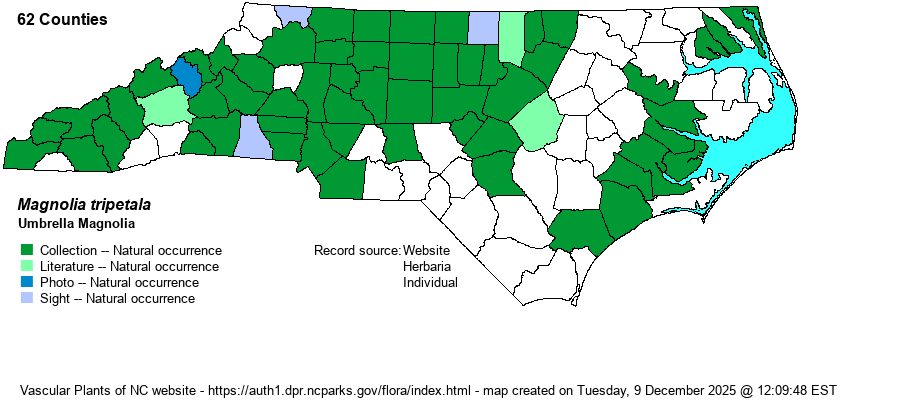| Author | (L.) L. | |
| Distribution | Essentially throughout the Piedmont. There is a real hiatus in the range, with the species again appearing in a narrow north-south band through the east-central Coastal Plain, from north of the Albemarle Sound to Pender County. This gap in the range is not an artifact of collection. Widely scattered in lower elevations of the Mountains, mainly in the southwestern counties. Absent mainly from the northern Mountains and the west-central Coastal Plain and Sandhills, as well as far eastern counties south of Albemarle Sound.
This is an Eastern species, ranging north to PA, OH, and southern IN, south to the FL Panhandle, MS, and OK. | |
| Abundance | Infrequent to fairly common across the Piedmont, found in most counties. In the east-central Coastal Plain, it is uncommon and local; absent in the Sandhills, other western Coastal Plain counties, and far eastern counties. Rare to uncommon in the southwestern Mountains, but rare farther northward. | |
| Habitat | This is a species of rich hardwood forests, mainly on slopes and ravines. The soil is often not circumneutral, but it can occur over mafic rocks. Thus, it is most often found in the richer examples of Mesic Mixed Hardwood Forest natural community, but it can be found in Basic Mesic Forest. |
| Phenology | Blooms in April and May, and fruits from July to October. | |
| Identification | This is the most familiar magnolia to field workers in the central and eastern Piedmont, as its large leaves are easily noted in a forest interior. This is a small deciduous tree, mostly to 35-40 feet tall. As with several other magnolias, the leaves are grouped at or near the branch tips, in a whorl, making the long tapered leaf bases hard to see in some situations. The leaves are oblanceolate to obovate, entire, and average about 10-12 inches long, the largest simple leaves seen in most Piedmont forests. The flowers are quite large, with numerous white petals each about 4-5 inches long, mostly angled upward as opposed to spreading. Normally they can be seen from the ground, as the leaves are not so broad at the bases to block a view of them (unlike in Bigleaf Magnolia [M. macrophylla]). The other clearly deciduous magnolia in the Piedmont, Cucumber Magnolia (M. acuminata), has smaller leaves that are more elliptical (and rounded at the base) and are scattered along the branches as opposed to whorled near the tips of the branches. In winter, the very long and smooth purplish end buds, almost like a spear point, are easily seen. | |
| Taxonomic Comments | None
| |
| Other Common Name(s) | Umbrella-tree | |
| State Rank | S5 | |
| Global Rank | G5 | |
| State Status | | |
| US Status | | |
| USACE-agcp | FACU link |
| USACE-emp | FACU link |

